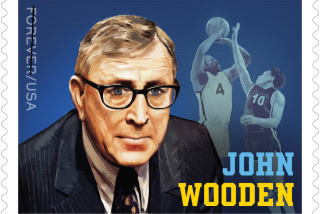New Self-Adhesive Stamp to Be Tested in 15 Cities
- Share via
WASHINGTON — After three years of research, the Postal Service has come up with a new stamp that doesn’t take a licking.
But the public will have to pay extra to use the self-adhesive stamps, and postal officials concede they are not confident the public is ready for that.
The new 25-cent stamps will be offered for sale for 30 days beginning Saturday in 15 test cities, including such major metropolitan areas as Los Angeles, Chicago, Cleveland, Atlanta and Miami.
The first customers who buy booklets of the stamps will be asked to fill out a questionnaire, rating the stamps and whether they were worth the roughly 10% higher price. Booklets containing 18 of the stamps will sell for $5, the same price as a booklet of 20 standard, lick-them-yourself stamps.
The square stamps, which carry an eagle and a federal shield, are described by postal officials as “the most thoroughly researched and tested” stamp the government has issued.
That was a clear suggestion that the new stamp should avoid the problems the Postal Service encountered with its first, and until now only, self-adhesive stamp 15 years ago. Postal officials said that most customers loved the stamp, but that it encountered a number of serious problems. The stamp did not adhere as well as traditional stamps and was very costly to produce.
Recently a new problem cropped up. Stamp collectors have been horrified to discover that the 10-cent 1974 stamp, a commemorative Christmas issue, has begun to destroy itself as its glue eats through the paper.
The 1989 version of the self-sticking stamp should take advantage of improved glues that the Postal Service said have made self-adhesive labels “commonplace in the workplace as well as in almost every household.” The service said it has become the largest user of the labels and, mindful of public requests for such a stamp, launched research into such a product in the spring of 1986.
In all, officials said they tested eight stamp shapes with focus groups and then ran 200,000 dummy stamps in the mail stream before opting for the square format.
More to Read
Sign up for Essential California
The most important California stories and recommendations in your inbox every morning.
You may occasionally receive promotional content from the Los Angeles Times.










